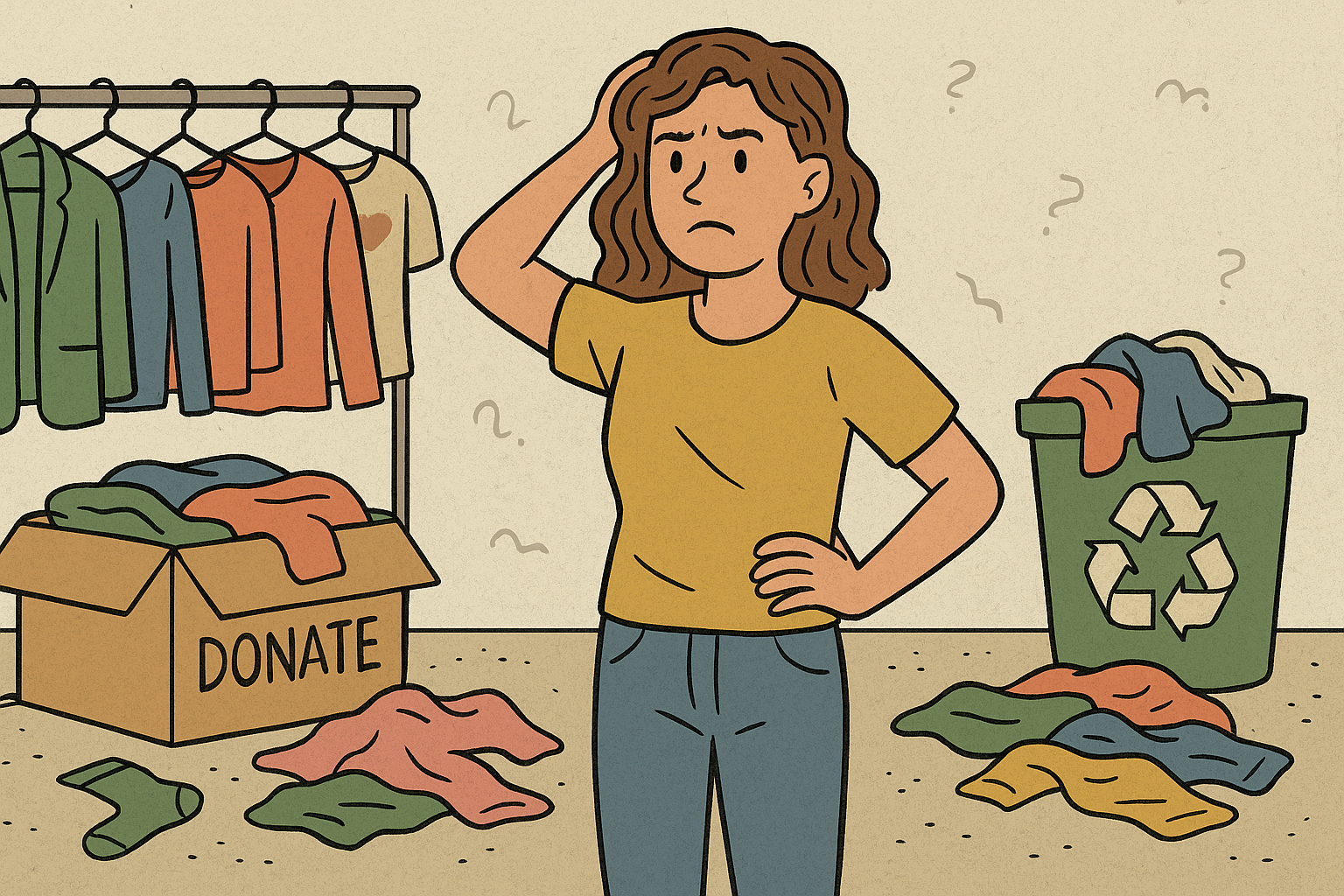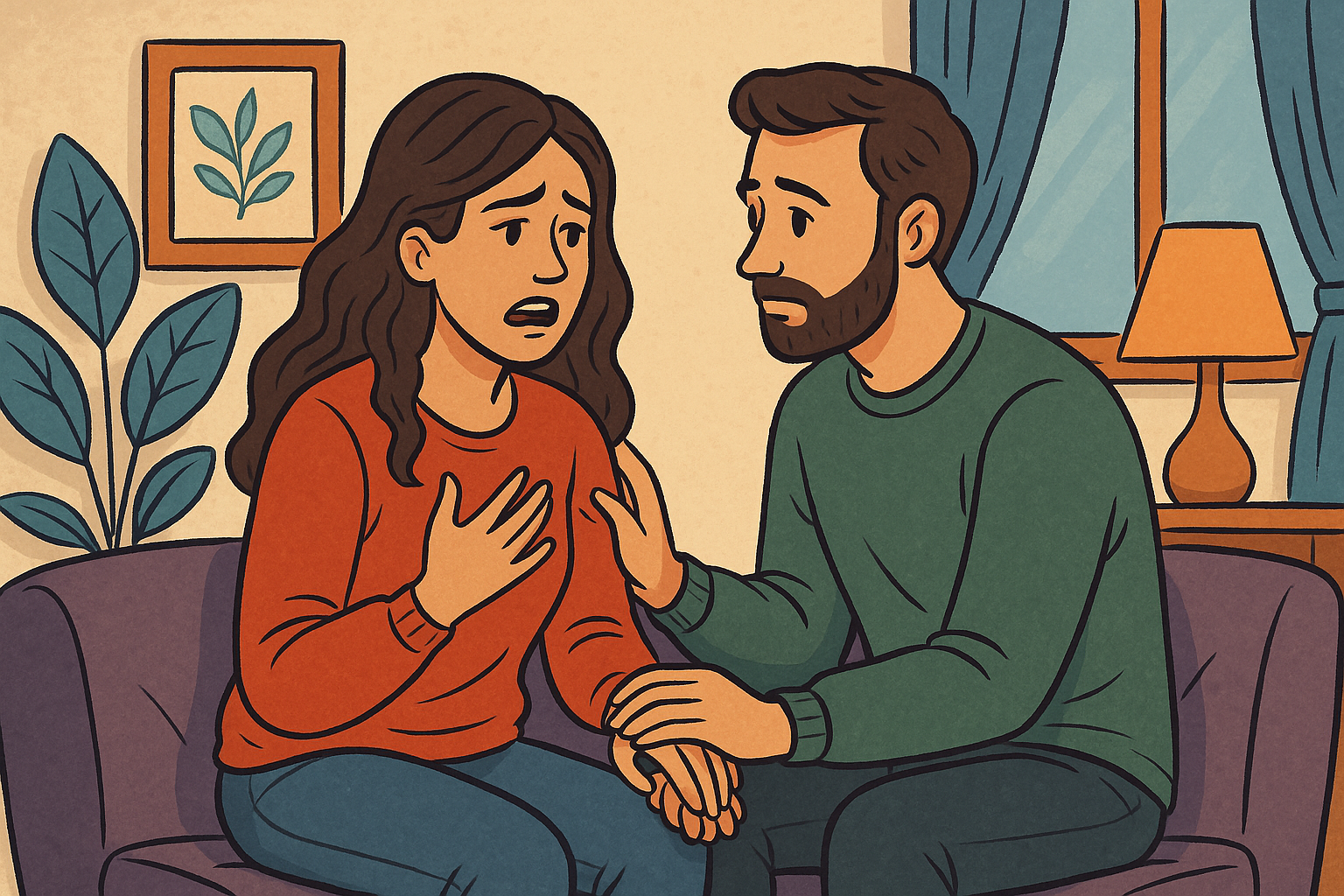BY AARDE WRITES for WEEKLY VOLCANO 10/24/25 |
Hey Aarde,
I’ve been going through my closet trying to make space and clear things out, but I just keep getting stuck. I don’t want to just throw my clothes away. A lot of them are still in good shape, just not my style anymore, or things I’ve outgrown (physically and emotionally, honestly). Some have memories attached, some I bought and barely wore, and others I feel like they should be useful to someone else. I just don’t know how to make that happen. I don’t know where to start, I don’t want to contribute to more waste, and I worry that donating to thrift stores isn’t enough. Are there better ways to recycle fabric or pass clothes along that don’t just end up in a landfill anyway? I’m trying to do the right thing, but it feels more complicated than I expected.
Signed,
Textile Tangent
Hey Textile Tangent,
Thanks for not only caring about our planet but also thinking outside the box. I believe fabric holds memory; you can often smell a lived experience through its threads. Textiles have been known to tell the history of a culture and community, and well-preserved textiles are honored for many reasons by historians, anthropologists, and curators alike. Whether its a garment passed down through generations, a protest flag representing an oppressed group, a uniform, or an expressive and artistic fashion, textiles can show evidence of the time, place, and intention of the people who wove and wore them. Modern fabric is also a magnification of the mass consumption of fast fashion and a clear window into the quick demise of our throwaway economy versus the longevity of quality. Clothing can tell a story in the closet, on the body, in the thrift store, or in a landfill; it does not discriminate. I am pleased to hear that you would like to participate in the storytelling of your fabric past.
As backward as it sounds, I’d like to first approach the act of buying new items. Consider researching and buying from ethical production companies such as Good On You, DoneGood or Remake.world. When we put an emphasis on purchasing items made from quality components, with long-lasting utilitarian design and classic forms, we will find much more use in the item, keeping it out of the waste bin. Focus on buying only items that are considered well made: natural fibers, better stitching, classic design. This will help you as you move forward, purchasing with power, not pointlessness. Overproduction leads to overdonation, a systemic cycle that is bound to drown in waste and exploitation of both workers and the elements of our Mother Earth.
I commend you for recognizing your part and deciding to act in a more conscious manner. Now, let’s talk about what to do with the reality of those unwanted items clogging up your closet, splayed over your treadmill like a dead body, or bagged up in your trunk for the last six months waiting for an excuse to live a new life.
I learned in a History of Garbage class at the University of Washington years ago, that most clothing donated to big-box thrift stores ends up in international textile markets, displacing local economies, with a large portion still ending up in landfills or incinerators. There is a difference between reuse, downcycling, and fiber-to-fiber recycling. True textile-to-textile recycling is rare (less than 1 percent), and many still think that “recycling” is a green fix, but bins are last-resort solutions, often ending in rags, insulation, or exported waste. So the fear of your clothes not seeing a second life, well lived, is realistic.
We must begin to donate responsibly by reaching smaller, local donation centers, churches, or nonprofits that engage in direct redistribution to the local community. Save time by learning what condition items must be in to be accepted before driving over with a car full of random items. Perhaps you can call ahead to see what the establishment needs, such as socks and coats in winter or business casual items for women reentering the workforce after leaving a domestic violence situation.
Here are a few options to consider:
- Just Threads Clothing Bank
- Tacoma Rescue Mission
- The Mission Thrift
- St. Vincent de Paul
- My Sister’s Pantry
- YWCA
- The House of Matthew
- InspireBig.org
- Life Center Clothing Bank
- Mary’s Place
- Local Buy Nothing groups
Wherever you decide to donate, knowing that your items are going to people who not only need but also appreciate them goes a long way. You can sleep better at night knowing that instead of your clothing cache being wasted, it is being used, helpful, and affecting someone’s life positively, which is much more than it did hiding in the depths of your closet.
Here is a step-by-step guide to processing your clothing to prepare for different stages of release. Start by sorting your clothes into three categories:
- Good condition and still wearable for someone else
- Too worn or damaged for regular wear but salvageable
- Truly worn out – no one in their right mind should wear
For the first two categories, decide whether to donate (local thrift), swap (create a swap party with friends or coworkers), or resell (try platforms such as Poshmark, Depop, ThreadUp, or TheRealReal).
For the third category, identify a textile recycling or repurposing path by searching online for “textile recycling drop-off near me” or “clothing recycling bin in [your city].”
If not available, see how you might convert the item for your own household use (cleaning rags, patchwork, etc.). Look on social media platforms that offer inspiration on textile recycling or crafts for ideas. (I’ve seen T-shirt collections turned into everything from quilts to teddy bears.)
My preference is to methodically repair items with creative visible mending, which lends itself to personalization and serves as a token of appreciation for the outlasting garment. Sashiko, an ancient Japanese visible mending process, is a personal obsession of mine.
Most importantly, set a deadline for the items you keep. For example, “If I haven’t worn this in the next year, it moves to the donate or resell pile.” This helps reduce the stuck feeling that comes from stuff just sitting. I’d suggest a full year for this process, as we tend to use our summer items for layering in winter, so many garments get dual seasonal usage. I have a donation tote in my basement that gathers items throughout the year. I take one final look before donating to ensure I have no second thoughts on any one item, making it more of a recycling-release ritual. Needless to say, how we buy, how we care, and how we let go all become a part of a larger story about who we are and how we treat our world. The children of the future will judge us on this, so go forth and be responsible.







